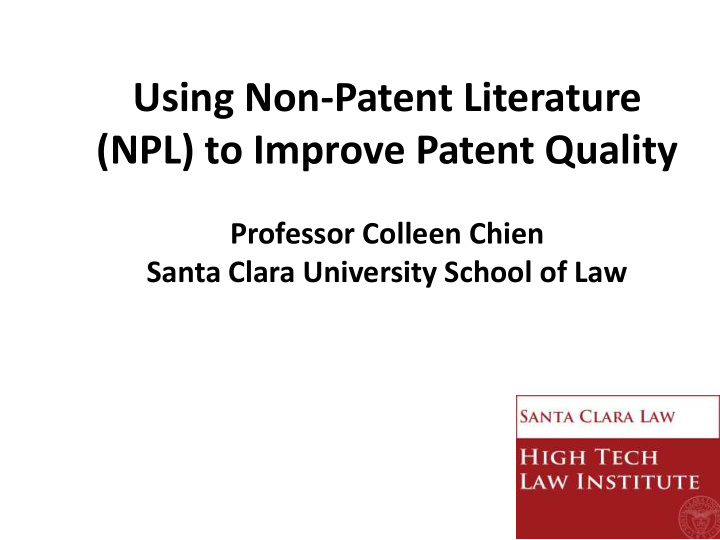



Using Non-Patent Literature (NPL) to Improve Patent Quality Professor Colleen Chien Santa Clara University School of Law
This presentation focuses on the citation of non- patent literature (NPL), which has been a recent policy priority, as a quality lever. Crowdsourcing Prior Art Executive Action to make it easier to share NPL Search Enhancement Programs - Automated Pre-Examination Search Pilot - Providing relevant prior art through an automated pre-examination search to an examiner for review before the examiner begins examination and conducts a manual search in the application - Scientific and Technical Information Center Awareness Campaign - Raising examiners' awareness of available search tools and resources to find better prior art in an application Global Dossier Initiative – Short Term Goals - Proof-of-Concept for Inter-Office Exchange – sharing documents between offices, e.g. prior art exchanges. - Alerting Functionality – an automated mechanism that alerts other offices, applicants, and/or representatives when there is a change in the status of an application 2
This presentation considers US and EP citation of NPL and outcomes at “matched pair” levels - “Exact match” matched pair approach for prosecution outcomes (Graham & Harhoff, 2006). Filing date / priority date matches. - Data source: Innography - Related work: Jensen, et al. (2005, 2007, 2008 2011, 2014), Graham & Harhoff (2006, 2009), Wright (2009), Sampat et al. (2015) Exact Match Source: Chien 2016, Comparative Patent Quality 3
Source of NPL data Google Patents, 2015 Edition: 4
What happens when the same patent application is submitted to the EPO and USPTO? application 5
What happens when the same patent application is submitted to the EPO and USPTO? application While time for searching prior art varies, EP prior art searching take ~8-12 hours on avg., vs. ~2 hours on avg. at the PTO ( van Pottelsberghe de la Potterie (2011), EPO) 6
EPO examiners are more likely to cite NPL FIG___: US v. EPO Examiner Use of Non-Patent Literature (~7K 2002 Matched App Pairs) 27% Chemistry 59% 13% Electrical engineering 50% 6% Mechanical engineering 29% 11% Instruments 34% 6% Other fields 20% 14% Average All 44% 0% 20% 40% 60% 80% US Examiner-cited NPL EPO Examiner-cited NPL Matches generated with Innography NPL data: EP Register 2015, USPTO PAIR 2015, Google Patents (Front Page information) Source: Chien 2016, Comparative Patent Quality
Time pressure during examination is nothing new Jefferson was “quite favorable to the granting of patents, and granted them with great consideration, the other duties of members of this Board, in view of their high offices, made it impossible for them to devote much time to this work. As a result the law was changed in 1793 to make the granting of patents a clerical function.” – PJ Frederico, 1952
There is a venue that cites NPL more than EPO…
The PTAB is more likely than the EPO or PTO to cite NPL in its decisions Citations of Non-Patent Literature in Different Venues (N~=311 IPRed patents subject to a final determination) 45% 40% 40% 35% 30% 30% 25% 20% 16% 15% 10% 5% 0% PTAB NPL Rate EPO NPL Rate (N=~169 Examiner NPL Rate Matched EPO Apps)
One Example – the 6,032,137 DataTreasury Patent - In 2015, the PTAB revoked the ‘137 patent as overly broad and vague, and therefore invalid - The Community Bankers of Amerca hailed the verdict “a victory for community banks. By that time DataTreasury and its two employees had already collected $350M in licensing fees.
The ‘137 DataTreasury patent was the subject of 7 EP Applications, none of which matured into a patent 12
Recommend
More recommend